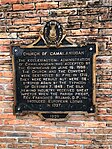Camalaniugan Church Ruins
| Camalaniugan Church Ruins | |
|---|---|
 The church ruins in 2006 | |
 | |
| 18°16′15.6738″N 121°40′31.6897″E / 18.271020500°N 121.675469361°E | |
| Location | Camalaniugan, Cagayan |
| Country | Philippines |
| Religious institute | Roman Catholic |
| History | |
| Status | Ruins |
| Founded | 1596 |
| Architecture | |
| Functional status | Inactive |
| Heritage designation | National Historical Landmark |
| Architectural type | Church building |
Camalaniugan Church Ruins are ruins of a Roman Catholic church located in Camalaniugan, Cagayan, Philippines. Built in 1596, the church was dedicated to Hyacinth of Poland, a Dominican priest and saint.[1]
History
[edit]The local people of the Camalaniugan were friendly to the Spanish missionaries, which led to the founding of the church in 1596.[1] Overlooking the Cagayan River,[2] the first church was believed to have a roof of thatch.[3]
From the 17th to 19th century, the Camalaniugan Church was damaged by earthquakes, floods, fires and typhoons, and repeatedly repaired. In 1898, a typhoon unroofed the church. However, the church was not repaired after the typhoon as its wall was already crumbling into the river, and a new church was planned to be buillt in another location away from the river.[4]
Present
[edit]The National Historical Commission of the Philippines declared the church as a national historical landmark in 1939.[5]
Today, the old church's ruined walls are still visible. In addition, the kiln that was used to produce the bricks for the church is still standing.[6] Between the church ruins and the kiln, the current Camalaniugan Church is located, as well as a new belfry, built in 1998.[4]
Artifacts and Structures
[edit]Bell
[edit]The current Camalaniugan Church houses the oldest bell in the Philippines.[7] The bell was cast in 1595 with "Santa Maria de Binalatoca" inscribed.[8] It was believed to have come from the town of Binalatongan, presently known as San Carlos in Pangasinan.[9][10] It was brought to Camalaniugan when the town of Binalatongan was burned during the Palaris Revolt in the 18th century.[4]
Kiln
[edit]The kiln that was used to made bricks for rebuilding the church is still standing.[6] It was estimated to have been built in the 18th century.[4]
Gallery
[edit]-
1595 bell
-
Historical marker installed at the current church building
-
Kiln to produce bricks
References
[edit]- ^ a b History from the People: Batanes, Cagayan, Isabela, Nueva Vizcaya, Quirino, Benguet, Ifugao, Kalinga-Apayao, Mt. Province. National Historical Institute and Philippine National Historical Society. 1998. ISBN 978-971-538-124-6.
- ^ Survey Report on the Protection of Cultural Heritage in Republic of the Philippines (PDF). Japan: Japan Consortium for International Cooperation in Cultural Heritage. 2014.
- ^ The Philippine Islands, 1493 1898: Volume XXX. BoD – Books on Demand. September 25, 2019. ISBN 978-3-7340-7763-0.
- ^ a b c d "Philippiniana Sacra; Volume 54, Issue 0162 (May-August 2019)". ustdigitallibrary.contentdm.oclc.org. Retrieved March 9, 2024.
- ^ "Church of Camalaniugan | Registry". Retrieved March 10, 2024.
- ^ a b Salgado, Pedro V. (2002). Cagayan Valley and Eastern Cordillera, 1581-1898. Pedro V. Salgado, O.P. ISBN 978-971-23-3307-1.
- ^ The Philippines, Pearl of the Orient. Islas Filipinas Publishing Company. 1988.
- ^ "Old Sancta Maria Bell | Cagayan Tourism". Retrieved March 9, 2024.
- ^ Jose, Regalado Trota (1991). Simbahan: Church Art in Colonial Philippines, 1565-1898. Ayala Museum. ISBN 978-971-8851-13-5.
- ^ "San Carlos City". The Official Website of the Province of Pangasinan. Retrieved March 12, 2024.



